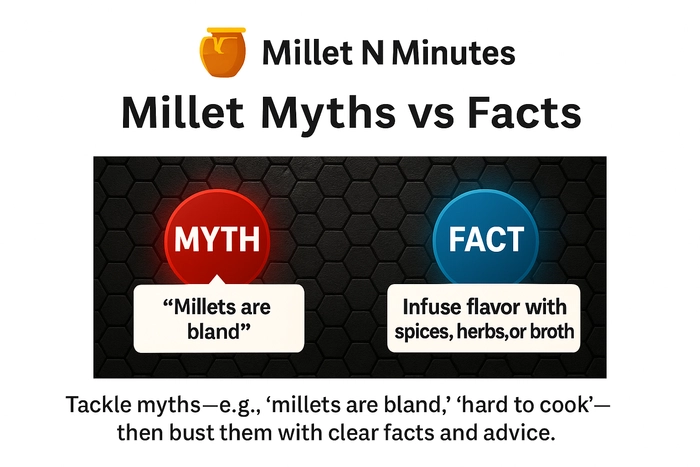Millet Myths vs Facts: Time to Rethink What You Know
For something so small, millets spark big opinions. Some say they’re old-fashioned. Others call them a passing health trend. And many just shrug and say, “Isn’t that bird food?”
It’s time we set the record straight.
Millets have been misunderstood for too long. These tiny grains are part of our heritage—yet they've somehow become victims of misinformation. Let’s unpack the most common myths surrounding millets—and uncover the truth.
Myth #1: “Millets are a poor man’s food.”
Fact:
This statement echoes a deep cultural bias. Millets were once widely consumed across rural India, not because they were inferior, but because they were local, seasonal, and sustainable. With time, polished rice and wheat became symbols of status, while millets were sidelined.
Today, millets are making their way back—not as a fallback, but as a forward-looking choice for those who value health, sustainability, and diversity in their food. It’s not about rich or poor—it’s about what’s real.
Myth #2: “Millets are outdated. We’ve moved on.”
Fact:
This myth says more about our perception of progress than about the grain itself. If moving on means choosing processed foods over time-tested crops, maybe it's time to look back. Millets have survived for millennia, not because of nostalgia, but because they work—with the soil, the climate, and the human body.
In a world facing climate change, water shortages, and gut health crises, millets might just be the future disguised as the past.
Myth #3: “Millets all taste the same.”
Fact:
That's like saying all fruits taste the same. Millets are a family of grains, not a single entity. Finger millet is nutty and earthy. Foxtail millet is light and fluffy. Kodo millet is delicate. Each has its own texture, flavor, and story. What we call “millet” is a universe in itself—one we’ve barely explored.
Myth #4: “They’re only for people with health problems.”
Fact:
Yes, millets are a great option for people managing diabetes, gluten intolerance, or digestive issues. But that doesn't mean they're limited to that box. Good food isn’t medicine—it’s prevention. Millets offer slow energy release, gut-friendly fiber, and essential minerals.
You don’t have to be unwell to eat well. Millets are for anyone who cares about nourishing themselves without hype.
Myth #5: “Millets are just a temporary trend.”
Fact:
Trends come and go. What stays are the things that work. Millets aren’t trending—they’re returning. What’s different this time is the context. Urban eaters are waking up to the need for sustainable, ethical, and local choices.
This isn’t just about millets—it’s about reclaiming forgotten wisdom and choosing what’s right for the world and our bodies.
The Truth?
Millets never needed a marketing makeover. What they needed was a chance to be seen for what they are: resilient, nourishing, diverse, and deeply rooted in our land and culture.
Let’s stop treating millets like a backup plan or a buzzword. Let’s treat them with the respect they’ve always deserved.
👉 Stay connected! Follow us on Instagram, Twitter, Pinterest, LinkedIn, and YouTube for the latest updates.


